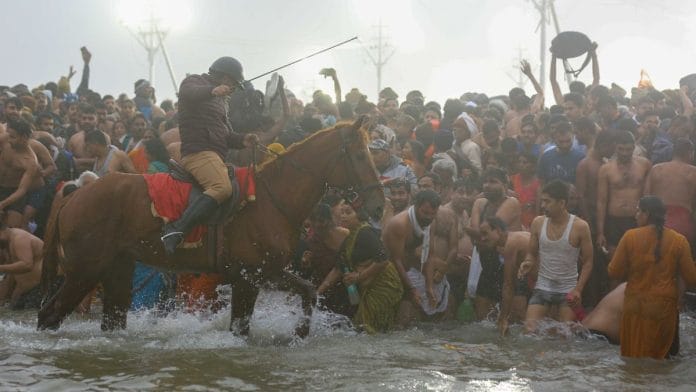The tragic incidents of stampedes, fire in tents, and other accidents in the Maha Kumbh Mela 2025 call for serious introspection on the part of the governments and the authorities vested with the responsibility of orderly conduct of such events. To say that in a congregation of millions, the death toll is just 30 is a shameful reduction of human misery to statistics. At the same time, belittling the massive arrangements made by the Uttar Pradesh government, or ridiculing the faith of millions of Hindus by saying a dip in the Ganga won’t end poverty, is abhorrent.
The UP government has ordered a judicial inquiry into the incident. The probe agency will take some time to come out with its conclusions as to what led to the tragedy. More importantly, it should also investigate if there has been any planned conspiracy to create chaos and stampede, which could have resulted in a tragedy of much larger magnitude. The ultimate idea behind such a conspiracy could be to suspend the ongoing religious rituals. Had this happened, the centuries-old practice of Maha Kumbh and the ritual baths, observed by everyone from Naga Sadhus and Akhara chiefs to the common man, would have been disrupted.
On its part, the government did expect a surge of crowd on the fateful day of the stampede, which took away many lives and left hundreds injured. The stakeholders were prepared to meet any eventuality. Probably, this preparedness saved many lives and kept the death toll low. Yet, while the authorities provided a definite route for the people to come for a dip in the river, adequate arrangements should have been made to clear the crowd through a different route. The stampede reportedly took place because those who had one dip in the river returned for a repeat even as a group of unruly elements destroyed the barricades and trampled upon people who were waiting for the auspicious moment.
Also read: Inside Elite Kumbh—no crowds, no chaos, only VIP Sangam, 5-star spirituality
Once in a lifetime dip
While every day of the month-long Kumbh Mela is important, the ritual bath at a specific time on Mauni Amavasya (29 January this year) is considered very auspicious. The Maha Kumbh Mela 2025 is the completion of the 12-year cycle of the Kumbh Mela, which is celebrated after 144 years. The alignment of the Sun, Moon, Jupiter, and Saturn with the Pushya Nakshatra constellation is considered auspicious in Vedic astrology, a fact that was common knowledge to the teeming millions in far hamlets all over the country. Besides, in an era of easily accessible social media, the Kumbh Mela this year gained even wider publicity and evoked tremendous interest among the poor, rich, educated, and the uneducated in equal measure. For many, this year’s Kumbh Mela was a once-in-a-lifetime opportunity to wash their sins off as none of them would survive to do that the next time, after 144 years, in 3069.
Kumbh Mela is considered one of the largest peaceful congregations of pilgrims in the world. The way it transcends differences of caste, creed, class, wealth and literacy in an otherwise caste-ridden, class-conscious, socially-divided and stratified society, adds importance to its uniqueness and salience. Held every three, six, 12, and 144 years, the Kumbh Melas have different connotations and venues like Prayagraj, Nasik, Ujjain, Haridwar, Kumbakonam in Tamil Nadu and after a 700-year break, in West Bengal’s Bansberia.
These religious congregations are orchestrated with military precision on specific dates and auspicious times, calculated down to the last millisecond, likely millions of years ago, as specified in the Hindu almanac, the Panchang. The Hindu calendar, Panchang (consisting of five components—Tithi, Vaara, Nakshatra, Yoga and Karana) follows a geocentric model of the solar system, defined by the movements of the Sun and the Moon around the Earth (Saura and Chandra māna respectively). It also integrates synodic, sidereal, and tropical elements. Little wonder that in 2017, the Kumbh Mela was inscribed on UNESCO’s Representative List of the Intangible Cultural Heritage of Humanity.
The last couple of decades have witnessed a resurgence of Hindu consolidation, projecting a renaissance-like situation in the country. On the one hand, it augurs well for the society to help cement differences and unite under one egalitarian philosophy. But if this resurgence results in ritualistic congregations of huge magnitude without discipline, accidents are bound to happen.
Since the Kumbh Mela involves, besides traditions and rituals, the study of science, astronomy, philosophy and spirituality, it can be a subject of research under the Indian Knowledge Systems (IKS) syllabus as envisaged by the National Educational Policy (NEP). Such studies should include temple administration, crowd control and management and effective event organising. Several Hindu organisations and temples have a large number of devotees who could be trained in crowd management and deputed in such places where more than seven and a half crore people gather on a single day.
Seshadri Chari is the former editor of ‘Organiser’. He tweets @seshadrichari. Views are personal.
(Edited by Ratan Priya)






